India’s Edelweiss AM says repo rate may hit 6.75% on inflation woes
2022.10.06 06:13
[ad_1]

© Reuters. FILE PHOTO: Nikhil Kumar Mondal, 65, a retired school headmaster, buys vegetables from a vendor at a market on the outskirts of Kolkata, India, May 20, 2022. Picture taken May 20, 2022. REUTERS/Rupak De Chowdhuri/File Photo
By Anushka Trivedi and Dharamraj Lalit Dhutia
MUMBAI (Reuters) – The Reserve Bank of India may have to hike the repo rate to as much as 6.75% as inflation remains a threat, lingering above the central bank’s target range for the remainder of the year, the head of fixed income at Edelweiss Asset Management said on Thursday.
The possibility of steeper rate hikes means that investors may be better served by investing in shorter term bonds, said Dhawal Dalal, chief investment officer of the fixed income division of Edelweiss Asset Management.
The fund’s base case is for a 6.5% terminal repo rate, but “sticky” food prices could push inflation above the RBI’s current projection of 6.7% in this fiscal year, Dalal said.
“In that situation, perhaps the RBI will be compelled to go above 6.5% on the repo rate…the policy rate will have to settle between 6.50% to 6.75% in the near term.”
Inflation-adjusted real rates will settle at a level that is “slightly positive” to allow the economy to grow, Dalal said.
Last week, the RBI hiked the benchmark lending rate by 50 basis points to 5.90% to tame stubbornly high inflation, its fourth straight increase, with markets expecting at least one more rate hike in the December.
Investors may prefer to buy shorter term bonds to escape interest-rate volatility, Dalal said, citing the flattening yield curve. “Market participants, in this case, feel they are not being compensated for the tenure of their investments.”
The five-year 7.38% 2027 bond yield was at 7.35%, while benchmark yield was at 7.45%, with just a 10 basis-point term premium.
The best way to play this situation is to be in the middle of the curve, by investing in securities maturing in the 4- to 7-year timeframe, he said.
GOVERNMENT-CORPORATE SPREAD TO RISE NEXT YEAR
The spread between government securities and bonds of top-rated corporations has shrunk substantially this year, as investors rush to pick up high-quality bonds in the face of low supply.
Corporates usually have to pay higher rates to compensate for the greater perceived risk, but top-rated companies are currently paying close to 7.57% for three-year funds and 7.65% for five-year debt, only marginally higher than the government’s borrowing rates.
As companies start borrowing more often, “at some point of time, we should expect normalisation (of spreads), but I think it will be in the new financial year and not this year,” Dalal said.
He pointed to the trend still favouring corporates, citing National Bank for Agriculture and Rural Development setting a coupon for bonds maturing in 15 years at 7.63%, just 1 bp higher than the government’s 14-year bond.
($1 = 81.3950 Indian rupees)
[ad_2]
Source link








